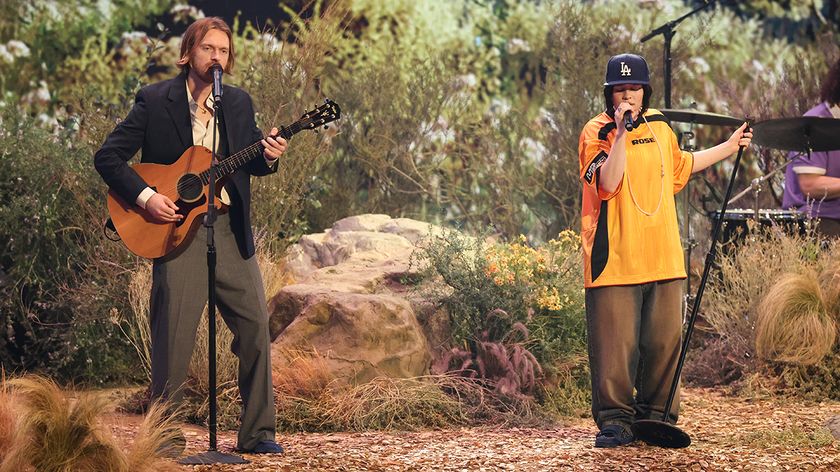Geezer Butler talks Black Sabbath, bass playing and The End
In-depth with the humble metal legend
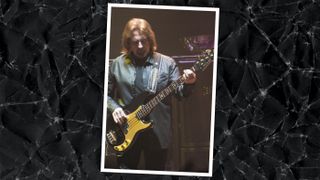
Introduction
From the throb of N.I.B. to the string-bending doom of God Is Dead?, the original wizard, Terry ‘Geezer’ Butler of Black Sabbath, has set the pace for bass players for nearly 50 years. We meet the master...
With his apocalyptic lyrics and sludge-heavy bass tones, Geezer Butler has inspired a legion of devotees worldwide. Born Terence Michael Joseph Butler to an Irish-Catholic family in 1949, he took up rhythm guitar and formed his first group, Rare Breed, at the age of 18 with pal John ‘Ozzy’ Osbourne, eventually crossing paths with Anthony Iommi and William Ward, who played in Carlisle blues-rockers Mythology.
Butler’s fascination with sci-fi , horror films and religion helped Black Sabbath create their own revolutionary style
After a cannabis charge-fractured Mythology, Rare Breed merged with Iommi and Ward to form Polka Tulk before changing their name to Earth and finally, at Geezer’s suggestion, Black Sabbath.
Combining elements of rock, blues, jazz, classical and prog with Butler’s fascination with sci-fi , horror films and religion, the new band created their own revolutionary style.
Sabbath sounded like iron giants lumbering through a war-torn wasteland, like the soundtrack to some cataclysmic battle between Satan and God, like the hairiest bunch of Aston sad sacks spared by fate from a life of toiling in slaughterhouses and sheet metal factories.
Armed with a fuzzed-out Fender Precision, down-tuned and coupled with wah, Sabbath’s bassist shook the devil from his strings and conjured runs both crushing and nimble, making his presence known even on quieter Sabbath songs like Solitude and Planet Caravan. Butler’s playing was mammoth but approachable, ancient yet fresh, legendary while firmly working class.
There is no sign of drugs, groupies, witches or booze - only steamed vegetables, grilled chicken and green tea
A beginner might lack the courage to take on Roundabout or YYZ but any young player could dig into the monster riff from Sweet Leaf and come out more confident on the other side. Simply put, he is the reason many of us first picked up the bass guitar.
After a powerhouse return to form on 2015’s stunning 13 album and the subsequent sell-out reunion tour, last month saw Ozzy, Tony and Geezer hanging up their boots following one last worldwide run.
As Sabbath headed full circle for a final pair of shows in their hometown of Birmingham, we caught up with the avowed vegan and defender of animal rights in Texas, of all places.
"Death, yeah"
It’s nearly 100 degrees as we’re ushered backstage. The Sabbath crew are proper English, extremely polite and generous. There is no sign of drugs, groupies, witches or booze - only steamed vegetables, grilled chicken and vats of green tea. A row of simple dressing rooms lies beyond the catering tent.
It’s a bit cooler inside. A Lakland bass sits propped beside a practice amp and there’s a large tapestry on the wall of a psychedelic skull. Geezer Butler, godfather of all things metal and rock, stands to extend the hand of doom. ‘Memento mori,’ we offer, meeting his handshake with a nod to the skull.
“Death, yeah,” he replies, chuckling while rubbing his chin. “It’s coming for us all, innit?”
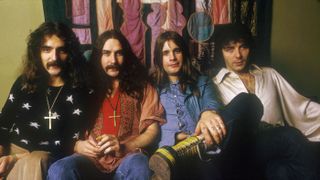
A beginning and an end
How does it feel to be here at The End?
“Terrible! Horrible! [laughs] Ah, bittersweet, actually. It’s good to go out on top. And we’re all going out as friends, which is the main thing."
Let’s go back to the beginning. In the pre-Sabbath days, you were on rhythm guitar. What brought you to bass?
I’d been wanting to switch to bass and hadn’t gotten one by the time we started rehearsing, so I had to play bass on my Telecaster
“Well, Tony didn’t like playing with other guitarists. We were really into Hendrix and Cream - bass, guitar and drums - and that’s the way we wanted to go. I’d been wanting to switch to bass and hadn’t gotten one by the time we started rehearsing, so I had to play bass on my Telecaster. We started out doing 12-bar blues stuff and I was just doing your very basic B/A/B, with no runs or anything like that. On the way to a gig, I borrowed a friend’s Höfner: that was the first time I’d ever played an actual bass.”
What bassists were you into?
“Jack Bruce was a huge influence. I was listening to a lot of Noel Redding and Charles Mingus as well.”
Mingus? There’s a lot of jazz in early Sabbath
“That was Tony and Bill, really. After Tony’s accident [Iommi lost two fi ngertips in an industrial accident], he learned a lot of chords from Django Reinhardt, because he also had two fi ngers. And Joe Pass as well. Bill was brought up on Gene Krupa and Buddy Rich. So I played off Bill’s swing feel, and that’s what brought the jazz to Sabbath.”
Your bass sound was different after Sabbath’s debut album in 1970. What was going on?
“I probably changed the strings on my bass! On the debut album I was too poor to buy new strings, so they were always, like, 10 months old. I’d only replace them if they broke, so that’s what gave the record that dull, flat thud sound.”
What were you playing through?
We didn’t know what we were doing on the debut LP... We weren’t allowed in on the mix or anything like that
“A 70W Laney guitar amp with a Park 4x12 cabinet with only three speakers. I couldn’t afford anything else. We didn’t know what we were doing on the debut LP. Treated it like a live show, really. We weren’t allowed in on the mix or anything like that. Two days to record and off to the continent to play some gigs. As time went on, I experimented with different setups and different basses. It could only get better.”
Did you have a sound in your mind you were looking for?
“I did, but it was so hard to find because technically, I wasn’t very proficient. I finally found it on 13. It took me 40 years!”
You were proficient enough to land a bass solo on the first record. That wah on Bassically was pretty radical. How did that happen?
“We actually wrote N.I.B. jamming on stage. Sabbath would play these places in Europe and have to do eight sessions a day. We’d run out of material so we made N.I.B. last 45 minutes! I used to do a 10-minute solo before we even started N.I.B., just to fill time. When we got to the studio I did a shorter version of the solo and the producer, Rodger Bain, suggested using a wah-wah to make it more interesting. I borrowed Tony’s pedal, simple as that.”
I’d love to hear a bootleg of an hour-long N.I.B.
“Me too, but I don’t think one exists.”
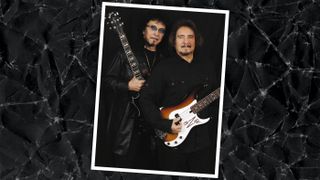
Mind-bending
You were bending your strings quite a bit, which wasn’t very common for bass players back then.
“Again, Jack Bruce. I saw Jack do it and simply copied his technique. It suited the sort of blues jams we were doing quite well.”
What did you think of Sabbath’s softer cuts like Planet Caravan and Laguna Sunrise?
Contrast makes things interesting. If you put on something lighter, it makes the rest sound that much heavier
“I like light and shade on an album, so I thought they were really good. I don’t like eight songs which all sound the same. Contrast makes things interesting. If you put on something lighter, it makes the rest sound that much heavier.”
Were you listening to bass players outside of rock? Your sound had a bit of funk edge to it, especially on cuts like Junior’s Eyes...
“Sure, yeah. I’ve always loved bass guitar, especially soul and R&B. James Jamerson was a genius player. Tamla Motown and Stax produced some great session bass players. I still listen to that stuff now, and newer stuff, like Bruno Mars. Funkadelic was fantastic.”
How did you create the bass-line for Children Of The Grave?
“I just followed the guitar riff. Tony started the track with a galloping riff and I followed that throughout the song. We always jammed songs until we were satisfied with how we wanted them arranged. I’d usually keep the first few ideas that I had.”
You guys tuned down to C# for Master Of Reality in 1971. Did you do that to make the sound heavier?
We tuned down to ease the pressure on Tony's severed fingers. Light gauge strings were hard to come by, so tuning down was the only way
“Tony started tuning down to ease the pressure on his severed fingers, because it was just bloody killing him, y’know? Light gauge strings were hard to come by back then, so tuning down was the only way to go. I tuned my bass down so as not to cause confusion when we were deciding what key a song would be in.”
What tuning do you use now?
“D, C and C#, depending which suits Oz’s voice. I usually take eight or nine basses on tour. Three main, three backups, one for the dressing room and one spare.”
You played some amazing licks on Vol. 4 in ’72 but they’re difficult to make out in the mix. What happened?
“That album was very badly produced, as far as I was concerned. Our then-manager insisted on producing it, so he could claim production costs. Those first albums have grown on me over the years, but at the time it was so different. I wasn’t happy with the bass sound, ever. I never could capture that live sound in the studio.”
What gear were you using on those early tours?
“Laney 4x12 cabs and 100W guitar amps. I had a Fender P-Bass, Dan Armstrong bass and then the John Birch and Jaydee custom basses.”
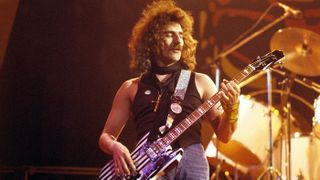
Custom rides
How were Jaydee and Birch customising for you?
“They built short-scale basses to my specs. I actually had the first guitar with crosses on the fretboard! Tony liked the idea and had a guitar made with crosses on his fretboard too. I loved the look of those basses, and still have them now.”
In early clips you played all fingerstyle, sometimes low near the bridge and other times high on the neck, even bashing the strings with your fist now and then. Did you ever use a pick?
I still play really hard with my fingers but I don’t bash about as much, especially since I’ve got arthritis in my thumb
“Only occasionally, if I had blisters on my fingers, or when the skin was sensitive from playing so much. On my solo G/Z/R albums I used a pick on some tracks to give a more aggressive sound. Also, a couple of songs were so fast, I had to use a pick to distinguish the notes. I used one on Children Of The Sea, I believe. I still play really hard with my fingers but I don’t bash about as much, especially since I’ve got arthritis in my thumb. I take care of my hands a lot better these days.”
Your tone on Heaven And Hell (1980) is massive. What were you doing in the studio?
“I was using my full stage rig, six cabinets and six amp heads! I didn’t know any better and it was the age of excess. All that and it still took weeks to get the right sound. Martin Birch was producing, and he helped.”
That line on the title track - you’re not following Tony there. How did you come up with that?
The bass part for Heaven And Hell was actually written by Geoff Nicholls
“The bass part for Heaven And Hell was actually written by the keyboard player, Geoff Nicholls. I liked it so much, I didn’t feel the need to change the verse parts. On that album I’d follow Tony’s riff to make some parts heavier, but then I’d go off on tangents. I had been out of the band a while and came back in really fresh and wanting to prove myself again. Also, since I was hearing the whole album for the first time, it gave me another perspective as opposed to hearing it a hundred times a day over the previous year.”
Mob Rules (1981) has even more bite than Heaven And Hell
“That’s right, yeah. The bass sound was by mistake! We were on tour and needed to write for the next LP, so we booked John Lennon’s studio in his house. It wasn’t long after he died, actually. They had this obscure, battered old Italian bass amp. I have no idea what it was, but I plugged it in and got this really great raw sound. We used it on the Heavy Metal soundtrack and it took me ages to get that sound again for the LP.”
Your bass had a really wicked grit on those tours
“We started from scratch, really. I was using JBL 12 and 15 speakers in huge PA cabs, Crown amps with Alembic preamps and custom BC Rich basses.”
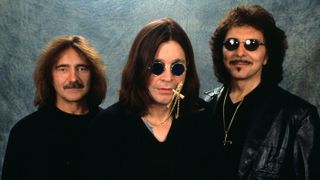
The Ironbird
What was that BC Rich you played at Live Aid in 1985?
“The Ironbird! That thing was impossible! It’s got a really spiky body and I whacked my thumb right on the point. Never played it again. Still got it, though. I’ve got all the basses I’ve used over the years. I’ve still got my Paranoid bass, the Heaven And Hell bass, the California Jam bass. Most everything, really. I don’t have the bass from the first record because we swapped it for the one I used on Paranoid.”
Then everything changed for Born Again…
[It's] Tony, Ozzy, Bill and me. I rather like the Ronnie James Dio era too. Everything else I don’t really consider Sabbath
“[Groans] I don’t even like to think about that album. To me there’s only one true Sabbath and that’s Tony, Ozzy, Bill and me. That’s the ultimate true Sabbath. But I rather like the Ronnie James Dio era too. Everything else I don’t really consider Sabbath.”
You say 13 is the first time you’ve ever truly captured your bass sound on record. How did you go about working with Rick Rubin to do that?
“When Sabbath reformed, I went back to my old way of playing fingerstyle because I wanted 13 to sound as close to our first three records as possible. But the engineer, Greg Fidelman, is the one who captured it. Rick told him what he wanted and he made it happen. It was a mixture of an original 1969 Ampeg 8x10 bass rig, an Ampeg Heritage 8x10, and various plugins. I also used a Bill Nash P-Bass as well as my Laklands.”
Damaged Soul is as strong as anything in the Sabbath catalogue
“That was a last-minute add-on. We used to jam for an hour to loosen up before we recorded anything, and that was an 18-minute jam that was luckily recorded. We tried to cut it properly but it didn’t have the same feel, so we edited the long version down to around eight minutes, added vocals and harmonica, and voilà!”
Have you ever considered returning to Sabbath’s roots for a blues project?
The follow-up to 13 was going to be a blues album, but the tour got in the way
“The follow-up to 13 was going to be a blues album, but the tour got in the way. It would take something like two or three years to do it properly, and we thought we might not all be here by that time, so it would be better to do this final tour first and then maybe we’ll do a blues record later.”
If you did it jam style it wouldn’t take that long to do blues?
“Probably not. You’d have to make it varied instead of doing 10 tracks of the same old 12-bar blues though. But even back in the Heaven And Hell tour days, Tony would go up into his lead and we would just jam around blues riffs for eight or nine minutes. And every night was different. So that is a thought.”

Touring demands
What does it take to do a tour like this in 2017?
“Lots of sleep, many cups of tea, some B-12 shots now and then. I don’t drink any more or do any kind of drugs.”
Live you can stretch out and try new things. Sometimes it works and other times it doesn’t, but it keeps it fresh
How would you have answered that question in 1972?
“Cocaine. Cocaine... (pause and laugh) Cocaine.”
What sort of warm-up do you do pre-show?
“Some runs, maybe a song or two, depends on my mood. Blues, a lot. And I’m still writing new stuff quite a bit.”
What song still gives you a thrill to play after all these years?
“Ah, Dirty Women. It’s different every night so there’s lots of room to improvise.”
Is there a temptation to revise or update parts as time goes by?
“I don’t exactly play the runs off the first albums. Those were done in such a short amount of time. You only had one take in the old days so you played it safe, basically, pardon the pun. Live you can stretch out and try new things. Sometimes it works and other times it doesn’t, but it keeps it fresh.”
What’s your favourite bass-line from the classic era?
“Probably After Forever.”
You always come off as very humble about your role. Why do think you’re considered such an innovator?
We always stuck to what we believed in. Sabbath was turned down by six record companies before we got a deal
“I don’t know! It's kind of a hard question to answer, really. I think it’s because we always stuck to what we believed in. Sabbath was turned down by six record companies before we got a deal. But we stuck to what we wanted to play and refused to change. I think the honesty comes over in our music.”
Nearly 50 years in, do you have any regrets?
“No, life always has ups and downs. I’m thankful I was able to have a life, as I think all life is miraculous and sacred.”
What will you do once the final show is done?
“I have no idea. Watch a bit of football, I suppose? I might not play music publicly but I’ll always be writing and I’ll still play every day. It’s my hobby as well as my career. I still love to collect guitars - and I still love playing bass.”

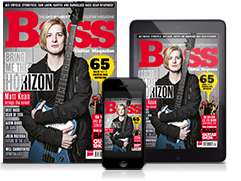
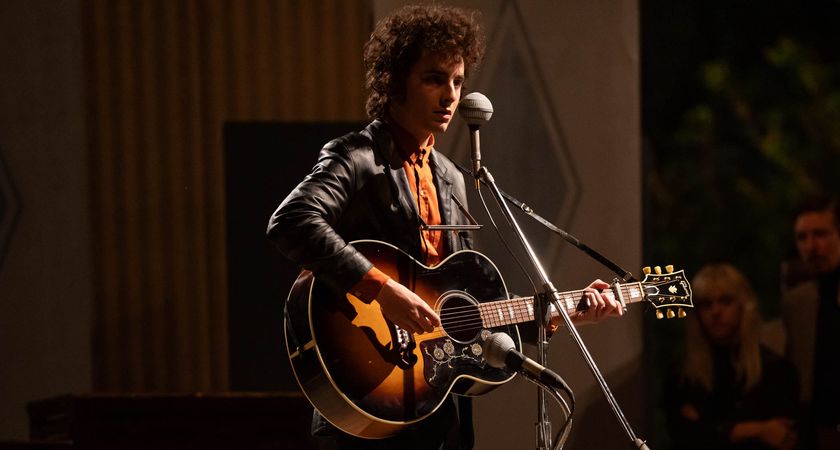
“I loved that he showed up with a $200 guitar… It’s humble”: Timothée Chalamet learned to play guitar for his Oscar-nominated role in Bob Dylan biopic on a beginner Yamaha acoustic
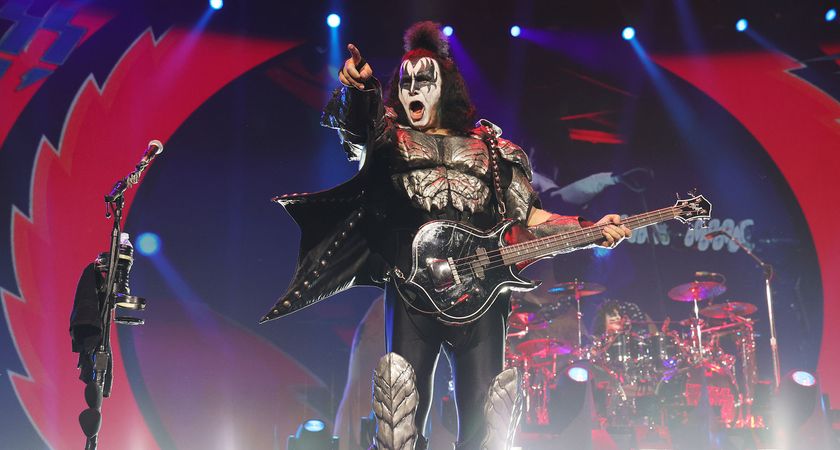
“AI is about as close to reality as you can ever imagine”: Gene Simmons discusses the prospect of a virtual KISS and says the “future of entertainment is here”

“I loved that he showed up with a $200 guitar… It’s humble”: Timothée Chalamet learned to play guitar for his Oscar-nominated role in Bob Dylan biopic on a beginner Yamaha acoustic

“AI is about as close to reality as you can ever imagine”: Gene Simmons discusses the prospect of a virtual KISS and says the “future of entertainment is here”
Most Popular








